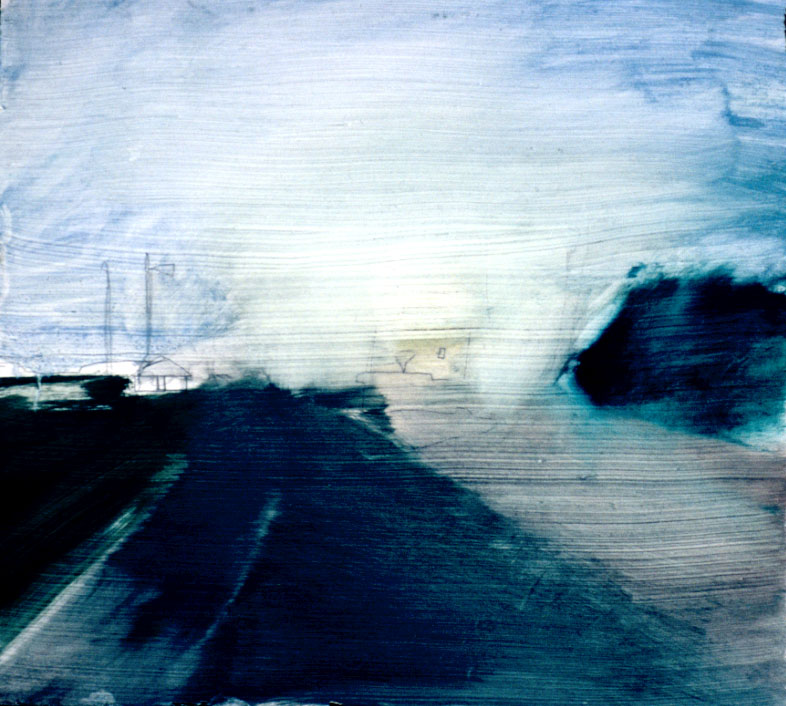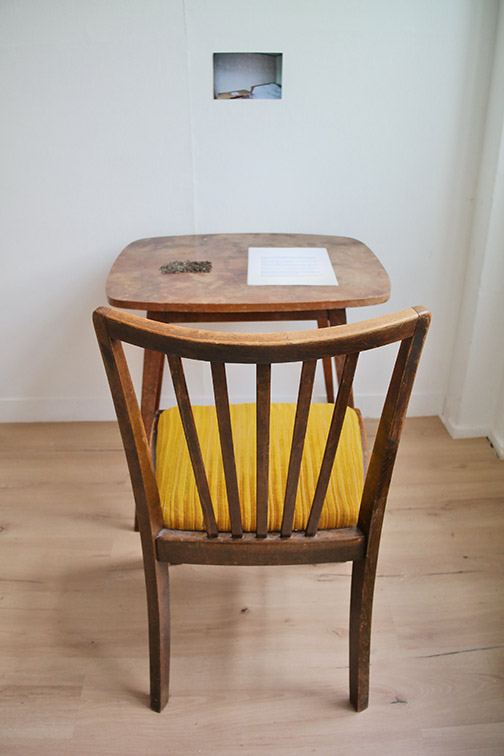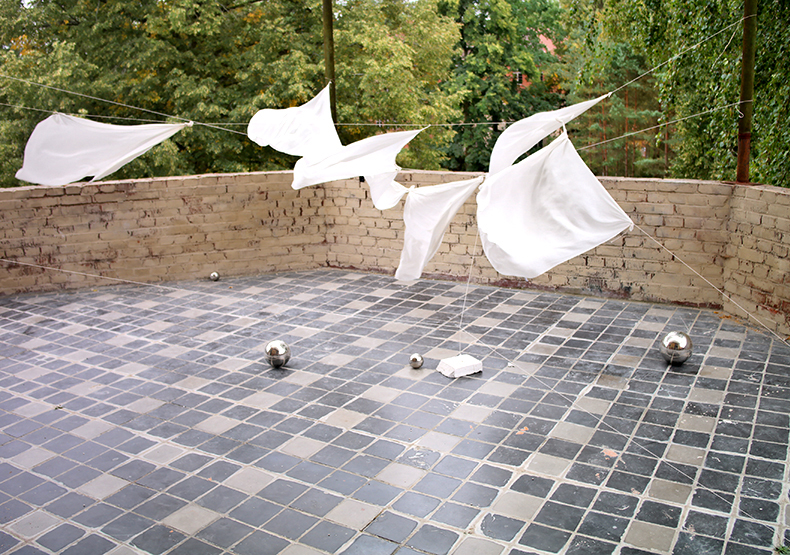Rachel Stevens: A few weeks ago you told a story about your Father the poet. Would it be interesting or relevant to tell that again?
Christine Cheung: My father always wanted to make art when he was in Hong Kong, and worked as a tutor, supporting his five siblings at the time. There was a well known master Chinese painter, Rong Shushi, part of the Lingnan School of Painting, who offered him lessons. My father could not afford lessons, but the painter offered to teach him anyway. A reprint of Shushi’s painting hangs at my parent’s house, as well as a painting by my father, which I ended up filming and is in the video The Days Without.
In Chinese landscape painting, poetry, calligraphy and image often go together within the same page. As far as I know, my dad didn’t really write poetry until recently. After he retired, my father started writing, sharing and critiquing poetry with various people online. I was a bit shocked as he gathered a community of thousands of friends online. Eventually, though, he stopped writing. I was always curious about his poetry (he sent me some recently—about the wind, about his relationship with his mother).
Later, my dad immigrated to Canada and eventually became a tax auditor in order to support the family. Through my career, his ideas of art have shifted as well. For example, my Dad once emailed the community centre about the mismatching colour of the walls in front of his house (with attached photos). I ended up making a small book about it and it became a kind of collaboration. Recently, he sent me some images about the patterns in the snow on the hood of the car, formed by the warm engine with a note: “This is art.” To me that is quite interesting, what he thinks of as art and not art, and how he has come to support my work.
My own work has been influenced by my father’s unique sensibilities. When I first started drawing realistically, my parents told me that despite how technically accurate it was in depicting the light and shadows, the “feeling” was most the important part. At the time I didn't know it, but that was an important lesson for me.

Horizon, oil on board, Halifax, Canada, 2005
The video you made for TEMP. FILES, The Days Without, is built from images of the landscape that you have collected, images which support the collaboratively written text that is superimposed. Learning more about your work, I see that landscape has long been a dominant theme in your painting and drawing, as well.
Yes, when I was a kid, we used to go for long car drives with the music on, and the landscape made a strong impression on me. The landscape became something to project my imaginings onto. I was reading about the painter Vivian Suter, and she had a similar experience. My family would drive around in the car, and finding beauty in the landscape was an activity. The car is particularly present in North America. You spend a lot of time in your car, and the expansive horizon and sky are a large part of the landscape, and it becomes ingrained into your consciousness as well.
My parents would say in Cantonese that we were going on a train ride, and I imagined some kind of magical train ride, but in fact, it would be just a ride around the boring suburbs to look at show homes or the scenery. The music would be playing, and it was a way to escape from personal issues and family conflicts. When I started painting, it was similar, I wanted to avoid depicting the problems of people, and emotional difficulties.
So, your parents, although not technically artists, infused you with a sense of magic or wonder in looking at the landscape.
Yes, I would say so, appreciating scenery was also an aesthetic activity.
Another aspect of landscape painting, or of gazing at the landscape, is that it orchestrates a detachment between you and the subject, while also promoting a feeling of mastery. You're getting an overview, or a contextual view, rather than having to encounter it one-on-one, with your body, in an embedded way. It's an ocular relationship that you have with that space or site.
Yes, the relationship to landscape is a relation to mental space or distance. That was the beginning thread for me, projecting one’s imagination or inner emotionality onto a landscape, which also connected to the aims of Chinese landscape painting. Canada has a history with landscape painting including Emily Carr, the Group of Seven. Often the landscape would be depicted as feminine, as passive, but the landscape also has an effect on us.

The Circle Game, acrylic on canvas, Indonesia, Jogjakarta, 2008
While your video The Days Without relies visually on landscape imagery, it leans at least equally on some collaborative writing, and even opens with the image of a book. Once you said you were a secret or closet writer. Tell me more.
As a kid, I read a lot of books and started writing short stories and have kept a journal ever since. I write sporadically but usually most of the content is therapeutic. I studied English Literature in University as well as Fine Arts, but my creative energy went more towards painting and drawing as in Canada, as the art departments were differentiated by medium. I always wanted to do a bit of everything.
I have written about other people’s work but never fully delved into my writing practice until more recently. While doing many residencies, I often turned to writing and photography to try to capture experiences that I couldn’t convey with painting or drawing. Writing is a way of letting go for me, a way to capture some memories, impressions, circumstances and anxieties.
Occasionally the writing was included into catalogues or my art practice—for instance, during a residency in Kameoka, Japan. As there is a deep Japanese tradition of craft and material exploration, I felt it was strange to paint in Japan. Instead, I ended up making a sound installation along with a short story that I wrote. A friend encouraged me to enter a short story contest and that was how I came to combine a text with installation in exhibition form for A Strong Wind.

A Strong Wind, installation, Berlin, Germany
and Kameoka, Japan, 2018
Over the last year, a friend who is a novelist, Jared Duft, invited me to co-write The Days Without, a shared notebook online which we plan to continue. It is an opportunity for me to condense my thoughts and write to an audience of at least one person. We have since published an excerpt with ANDPRESS which is the basis of the short film I made for TEMP. FILES.
I would say that in much of your work you have a ‘light touch.’ Maybe one thing I mean by that is that you leave meaning and associations very open. Another is that you are often using ephemeral materials and ephemeral situations figure prominently in your work. For example: wind, writing, clouds and other weather, brush writing as performance, the movement of human bodies. Are there particular works that drive these choices or, from your perspective, engage them for maximal effect?
I do tend towards gestural works and am drawn to that kind of expression as I think it reflects our experience in life. I prefer to leave some room for the viewer to come up with their own associations instead of closing them off.
As a painter, you are always playing with the limits of when something is “finished.” That has been one thread that has gone through my work from the beginning—how much do you offer to the audience and how much do you leave up to their own imagination. My work comes from a subconscious space, so I want to leave the viewer space for their own unconscious memories to be triggered as well. The space before waking, before judgment. This moment before we close interpretation is what expresses freedom in artwork—a reminder that any moment that can be art has potential for meaning.
That is a beautiful thought.
Thanks. I came to explore the gestural mark and expressionism when I first arrived in Europe, after completing residencies in places as diverse as Norway and Bangladesh, and for me the question of what is a worthy subject was difficult to answer.
In China, people used brushes with only water to practice calligraphy in the park, and I found it fascinating that they were more focused on the process rather than the end product. I did some works exploring that in the form of workshops, with a couple of dancers and performers in the series Invisible Drawings: Grey Area. Later, I learned about the Gutai movement (an avant-garde Japanese art movement which explored performative actions, often in public spaces) and that in the 2000s, the artist Song Dong also explored water calligraphy as well.
I am also interested in the spontaneity of the Fluxus movement (an experimental art movement from the 70s emphasizing process) and how contemporary art has much of its roots in Eastern philosophy. We are inundated with so much information, and to be able to have a light, clear mind is a difficult thing. I admire the expansive work of Agnes Martin, whose writings and paintings are influenced by Eastern philosophy and could be argued to be landscape based. She wanted her paintings to be like looking at the ocean or fields, which relates to my work as well. She made a film as well, which I would love to see.

Untitled, found silk scarves, metal balls,
Grabowsee, Berlin, 2018
Collaboration is a primary mode of making for you. How conscious a choice is this?
This is a tension in my work. I tend to work well alone as a painter. My approach to writing and painting is to create in secret at first so that I can try to convey a type of intimacy I would like to experience as a viewer.
Collaboration is a great way to extend my own artistic tendencies, to challenge myself to learn from others and create something I would not be able to create on my own. The chance to work with others comes up naturally, from my associations with the people around me. It doesn’t always work, but I find it interesting and learn from the process, usually with artists working in other mediums such as dance (as with Invisible Drawings: Grey Area), sound, video, theatre, and writing. It is a challenge to deal with collective logistics and group processes, but can be rewarding for learning and exchanging. TEMP. FILES was a great collective experience, getting feedback from others to shape an end result. The Days Without is definitely something I couldn’t have achieved alone.
I’m interested in how place and migration operate in your work. You migrate, identities migrate. Meanings and readings of images and artworks and people migrate, somewhat in relation to place, or via the positionality of both the maker and the viewer. You are Asian-Canadian living in Berlin, moving between Berlin and your home in Canada. How does this affect your work and in what ways, if any, is it an interest or concern of yours?
Yes, the fluidity of things is of great interest to me. It took me a while to get comfortable with that as an artist. I completed many international residencies over the years, so that the sense of being a stranger is familiar, and I developed a practice of creating ephemeral works with the materials at hand. Having transportable work is a part of being mobile. The fleetingness of our everyday experiences and memories are what we take with us. Finding ways of how we can express or convey those delicate moments of seeing, estrangement and wonder interest me.
While doing these residencies, I started to question the idea of integration in society, and understanding of others in traveling and tourism—how much do we really understand each other, how much do we really know a place? Some of my paintings were about my desire to see what I imagined or have seen before. I started to question what that means, culturally, when you shift places, along with the act of painting itself.
When I got to Berlin, it was much more about interiority. For me, Berlin is a place which has a history of trauma, but also hybridity, multiculturalism, and healing and provides space for people to create and express these fluidities. Having affordable housing, low living costs and having access to such a rich cultural scene is part of that as well. Berlin, with its specific history and also relationship to East and West, and international artistic community influences my work. I try to remain open and be receptive.
I love the mention of mundane characters and activities in the text for the film, like the dentist.
Thanks, yes the mundane things also are what create a sense of structure or ritual in our lives, something recognizable within all that change. Finding the unique moments in the mundane, or cultural difference (or lack thereof) is of interest because these seemingly boring things are what make up our cultural experiences.
As with any artist, one’s background definitely influences the work, depending on how aware you are of it. I have been involved in activism around Asian-Canadian identity in the past, but in my work my history, memory and experiences come out in the work subconsciously anyway. The experience of the diaspora was something I tried to explore merely through landscape painting and emotionality in the beginning of my career. Being away from home gives you a sense of freedom as well. I would not have maybe strayed from painting as much as I have, for example, or been able to feel as free to experiment and try things out.
 Karmangi Char, Black Waters,
Karmangi Char, Black Waters, acrylic on paper, Dhaka, Bangladesh, 2010
